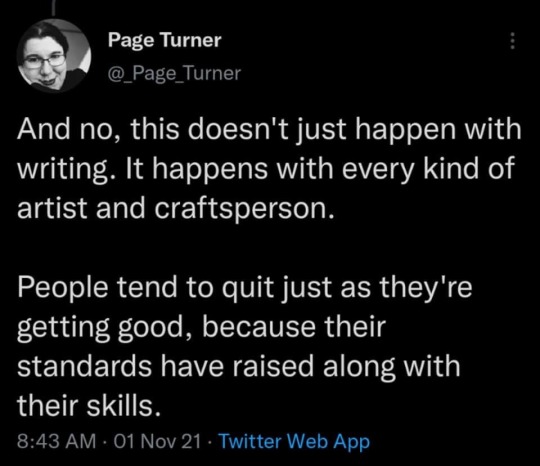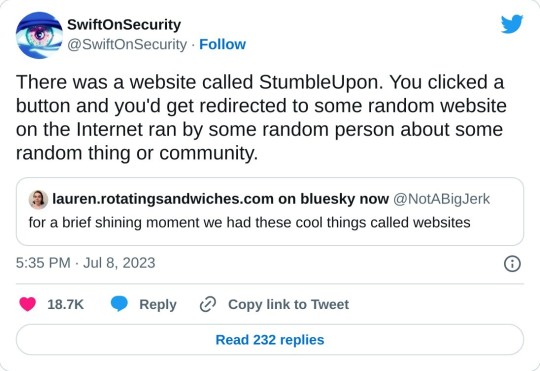Text






This hit home, and I think it will resonate hard with all my creative friends, here. You are amazing and brilliant and I BEG YOU to keep creating!! ❤️❤️❤️
39K notes
·
View notes
Text
If you have the opportunity to travel back several hundred years in time and you want to make a quick buck so you can set yourself up for success, the most valuable and lightest to carry things you can bring are:
1. Stainless steel needles
2. Cinnamon
Everything else is context dependent but those two will be winners in 99% of situations
1K notes
·
View notes
Text

Source

Source
13K notes
·
View notes
Text

Not what I expected coming from John Green
109K notes
·
View notes
Text
Weaponized incompetence my ass just weaponize it back. Once my dad tries to pull the “but I don’t know how to clean the counters as well as you” on my mom and she said “ok honey I’ll show you” and she made him stand in the kitchen and watch her clean the counters. Then she pulled out a bottle of chocolate syrup and proceeded to spray the entire kitchen in chocolate, hand him the sponge and said “okay now it’s your turn”
147K notes
·
View notes
Text
The discovery represents a potential new way to recruit the immune system to fight treatment-resistant cancers using an iteration of mRNA technology and lipid nanoparticles, similar to COVID-19 vaccines, but with two key differences: use of a patient’s own tumor cells to create a personalized vaccine, and a newly engineered complex delivery mechanism within the vaccine.
Within 48 hours, the four human study participants showed remarkable results: their immune systems went into turbo cancer-destroying mode. And without surgery, radiation, or dangerous chemotherapy.
Folks, we may have a cure for cancer within your lifetime.
16K notes
·
View notes
Text

I can't stress enough how much I miss StumbleUpon
118K notes
·
View notes
Text
I feel this so hard. Like, we bought a house and pulled up carpet to reveal hardwood floors (score).
They have nicks and scratches and aren't perfect, but I love that because it means I don't have to be so precious about them and if I glitch and over water a plant, the accidental ring sucks but isn't devastating.
I've always said I never wanted things so expensive that I'd cry if I lost them or they broke. Apply that to cars, phones, clothes, etc. It doesn't mean I don't care about quality... But there's a line between good things and things I feel like I have to handle with kid gloves.
so i complain a lot about low build quality of modern durable goods, but i do think there's a lot of freedom in having durable goods that (while they meet or exceed a minimum level of functionality) you aren't tempted to Keep Nice.
i don't care if my cat sharpens her claws on the couch because it's an ikea couch i got for free off a friend who was moving away. i don't care if my car gets scratched because it's already dinged up and it doesn't make it any less drivable. i don't care if my desk chair upholstery gets stained; it was cheap and who gives a shit if my chair is grungy. in many cases i actively disprefer the Nice version of the thing (like, say, a fancy expensive car) because it's emotionally a lot harder to blow off incidental damage.
this is also a thing that's really nice about DIYing/thrift flipping furniture and shit: i don't care that much if i scratch up the finish on my desk because -- well, it's a desk. who cares if a desk is scratched?? but also, i built the damn thing, so i can just sand it and refinish it with the exact same varnish. i could reupholster the various cat-scratched furniture, if for some reason i wanted to do that. i CAN, in fact, Fix Him.
i grew up in a house with a bunch of Nice Furniture, including (most frustratingly) antiques where you absolutely could not leave anything wet on them ever. a couple times, in the course of lighting birthday candles, the kitchen table accidentally got match-scorched, and my mom STILL tisks over those burn marks every time she remembers they exist. and i have to say, constantly Being Careful of the Furniture did and still does drive me up the wall. it's exhausting. like -- you don't have to spend mental energy on that!! you can refinish the dang table! you can, idk, lasercut some clear acrylic sheets to put on top of the antique dresser set! you can also decide to just not care about your stuff displaying the ordinary signs of wear and tear from being lived with, instead of trying to make a home a furniture showplace. every time i look at the scorch marks on my parents' kitchen table, i remember eating birthday cake.
4K notes
·
View notes
Text
You’d known, intellectually, that your heroic nemesis was a teenager, but it didn’t really sink in until the day their school called because your number was the only one on their emergency contact list.
39K notes
·
View notes
Text
A reef that has been degraded—whether by coral bleaching or disease—can’t support the same diversity of species and has a much quieter, less rich soundscape.
But new research from Woods Hole Oceanographic Institution shows that sound could potentially be a vital tool in the effort to restore coral reefs.
A healthy coral reef is noisy, full of the croaks, purrs, and grunts of various fishes and the crackling of snapping shrimp. Scientists believe that coral larvae use this symphony of sounds to help them determine where they should live and grow.
So, replaying healthy reef sounds can encourage new life in damaged or degraded reefs.
In a paper published last week in Royal Society Open Science, the Woods Hole researchers showed that broadcasting the soundscape of a healthy reef caused coral larvae to settle at significantly higher rates—up to seven times more often.
“What we’re showing is that you can actively induce coral settlement by playing sounds,” said Nadège Aoki, a doctoral candidate at WHOI and first author on the paper.
“You can go to a reef that is degraded in some way and add in the sounds of biological activity from a healthy reef, potentially helping this really important step in the coral life cycle.”
Corals are immobile as adults, so the larval stage is their only opportunity to select a good habitat. They swim or drift with the currents, seeking the right conditions to settle out of the water column and affix themselves to the seabed. Previous research has shown that chemical and light cues can influence that decision, but Aoki and her colleagues demonstrate that the soundscape also plays a major role in where corals settle.
The researchers ran the same experiment twice in the U.S. Virgin Islands in 2022. They collected larvae from Porites astreoides, a hardy species commonly known as mustard hill coral thanks to its lumpy shape and yellow color and distributed them in cups at three reefs along the southern coast of St. John. One of those reefs, Tektite, is relatively healthy. The other two, Cocoloba and Salt Pond, are more degraded with sparse coral cover and fewer fish.
At Salt Pond, Aoki and her colleagues installed an underwater speaker system and placed cups of larvae at distances of one, five, 10, and 30 meters from the speakers. They broadcast healthy reef sounds – recorded at Tektite in 2013 – for three nights. They set up similar installations at the other two reefs but didn’t play any sounds.
When they collected the cups, the researchers found that significantly more coral larvae had settled in the cups at Salt Pond than the other two reefs. On average, coral larvae settled at rates 1.7 times (and up to 7x) higher with the enriched sound environment.
The highest settlement rates were at five meters from the speakers, but even the cups placed 30 meters away had more larvae settling to the bottom than at Cocoloba and Tektite.
“The fact that settlement is consistently decreasing with distance from the speaker, when all else is kept constant, is particularly important because it shows that these changes are due to the added sound and not other factors,” said Aran Mooney, a marine biologist at WHOI and lead author on the paper.
“This gives us a new tool in the toolbox for potentially rebuilding a reef.”
Adding the audio is a process that would be relatively simple to implement, too.
“Replicating an acoustic environment is actually quite easy compared to replicating the reef chemical and microbial cues which also play a role in where corals choose to settle,” said Amy Apprill, a microbial ecologist at WHOI and a co-author on the paper.
“It appears to be one of the most scalable tools that can be applied to rebuild reefs, so we’re really excited about that potential.”"
-via Good News Network, March 17, 2024
2K notes
·
View notes
Text
Making Yourself Damage Resistant (PART 1)
Life can sometimes shake us up! Here's how we can be a little more prepared.
General resistance training will help condition our bones, muscles, tendons, etc for high forces - those are usually the ones that hurt us!
But we don't *just* want to be stiffly strong. It also helps to be spry and mobile! Injury often happens when we're stretched out - which happens both in and out of the gym or training environment. So consider full range of motion!
3K notes
·
View notes



